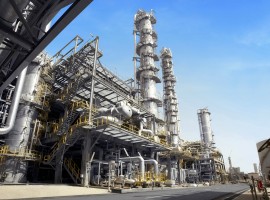By Sarah Samir
Ensuring the safety and the quality of pipelines is one of the main priorities of the oil and gas sector. In Egypt, as in many other countries, the high temperature and humidity are challenging the performance of those pipes. Many onshore pipeline accidents are caused by corrosion. However, although corrosion challenges are still very present in the industry, it can be largely decreased by following anti-corrosion techniques, including cathodic protection (CP) and several pipelines coating methods.
Pipeline Materials
Before installing a pipeline to transmit hydrocarbon, the operator firstly decides on the material from which the pipeline is manufactured. In order to bear natural circumstances like heat and humidity, and to be able to survive the nature of the fluid or gas that it will transport, as well as the pressure, pipelines should be made of strong material.
Industry experts prefer using steel pipelines, whether carbon steel, stainless steel, or alloy steel. Particularly, operators mostly resort to carbon steel, according to the Canadian Energy Pipeline Association (CEPA). Carbon steel is usually selected as it is able to bear high-operating pressure and temperature. It is also easily welded, can be protected from corrosion, and has the ability to remain in service if maintained properly, according to CEPA. Yet, the material alone is not enough to prevent corrosion, as safety measures need to be fulfilled.
Causes of Corrosion
When a pipeline corrodes, there is a high probability that work will be delayed due to the required maintenance. Oil and gas
leakages originated by corrosion potentially cause accidents that lead to the closure of the pipeline, besides harming the environment of the neighboring region or the marine life if it is an offshore pipeline.
Corrosion has different types based on the cause and nature of it. Generic corrosion happens when the pipeline’s metal loses its uniform, and leads to eroding the metal with high-velocity fluid, according to an article published by African Review.
Another type of corrosion is the galvanic one, which takes place “when two metals with different electrode potentials are connected in a corrosive electrolytic environment,” according to the article.
Crevice corrosion happens in crevices and only with bolds, gaskets, and cap joints, while concentration cell corrosion takes place in areas with low fluid velocity or in presence of stagnant fluid due to the exposure to “electrolytic environment where the concentration of the corrosive fluid or the dissolved oxygen varies,” as the article points out.
Other types of corrosion include microbiological induced corrosion, in which chemical and physical interactions take place due to the existence of biological growth in the pipelines, as well as the graphitic corrosion, which is led by the loss of iron ions in acids and salt water in case of cast iron pipelines, according to African Review.
Pipeline corrosion is thus affected by the nature of the surrounding environment. Accordingly, from the unavoidability of the nature in which the pipeline is placed – whether in deserts, underground or subsea –comes the need to use proper protection methods.
Pipelines Coating
In order to protect the pipeline, the metal could be coated with material that protects it from corrosion. “Pipeline coatings are the number one defense against corrosion,” Mahmoud Rapoh, team leader at the W/D Corrosion & Inspection Management Department at Khalda Petroleum Company, told Egypt Oil & Gas.
The industry has mainly applied pipeline coating inside the oil and gas fields for around 55 years due to the speed and cost, according to Argus Limited’s article on pipeline corrosion protection. It was not very challenging to coat long pipelines as the operators used a special an automatic machine called line travel CPT, while hand operated machines were used for short pipelines, the article explains. However, as technology and science progressed, and as coating method users increased, operators started to lean towards applying pipelines’ coating in specialized plants, which became more reliable and cheaper compared to those applied in the field, the article stated.
The internal coating liner of a pipeline is required to protect the metal from the pressure of the transported product. It is “applied prior to installation of virgin pipes or for repairs and replacement pipes,” an article published by Pipeline & Gas Journal states.
Moreover, pipelines should be secured from any external surrounding environment. Accordingly, external coating protects the pipeline “against a variety of dangers arising from soil stress, soil-born chemicals and salt water. Pipelines must be resistant to indigenous bacteria, other flora, wastewater and the chemicals and solvents used in the processing of the hydrocarbons,” the article adds.
According to Rapoh, coating protects metals from the diffusion of oxygen and water, slowing corrosion. “The anti-corrosive pigments contained in quality primers change the surface properties of the base metal. The metal develops a high electrical resistance as a result. Different pigments accomplish this reaction in different ways. Primer absorb and tie up moisture so that it does not react with the steel” he said.
There are five systems used to coat oil and gas pipelines. Three-layer PE coating, which has a 50% market share of the global markets, is best used in temperatures ranging from -45°C to 85°C, according to the Pipeline and Gas journal. Moreover, there is the three-layer polypropylene (3LPP), which is used for pipelines going through extreme mechanical stress. This coating system is best used in temperature ranging between 0°C and 140°C.
To coat pipelines, operators also follow the polypropylene (PP) coating system, which is used to challenge any deep-sea project using external pressures and high operating temperatures, the article points out.
Coating systems further include fusion-bonded epoxy (FBE) and the PUR system. Newly-installed pipelines are mostly coated using “3LPE, 3LPP and, up to seven layers, PP plus FBE, while for repairs, PUR is the coating of choice,” the magazine says.
Cathodic Protection
As metal pipelines could be damaged due too external effects, not just internal contents, operators resort to CP in order to counteract the external corrosion through the use of direct electrical current, according to NACE’s article on pipeline corrosion.
Metal corrosion is caused when oxygen, water, and other impure element like sulfur are present, which makes metals be an anode through losing their electrons. Hence, “the metal becomes oxidized and corroded. CP simply supplies the metal with electrons from an external source, making it a cathode,” according to Inspectioneering’s overview of CP.
In order to perform CP, the operator should decide on the amount of current used in the process. This is decided based on how much metal surface is exposed and the surrounding environment’s depolarizing capabilities, according to an article published by the US Department of the Interior Bureau of Reclamation Denver, Colorado.
For proper CP, “the protected structure must be polarized to a certain value. The polarized potential is measured with respect to a certain reference electrode. A copper/copper sulfate reference electrode (CSE) is the most common electrode used in soil and freshwater,” said Rapoh.
There are two types of CP: galvanic anodes cathodic protection, and impressed current cathodic protection.
The galvanic protection is “achieved by connecting the protected structure to a sacrificial anode, which is placed close to the protected structure,” Rapoh stated.
In this CP technique, “Sacrificial anodes are made from active metals such as zinc, aluminum, or magnesium,” while the current is produced using “the potential difference between sacrificial anodes and the protected structure,” Rapoh explained, adding that the used type of anodes is selected based on the “electrolyte resistivity and the chemical compositions of the electrolyte to which the substrate is exposed.”
Yet, it might seem uneconomic to apply galvanic cathodic protection on long pipes. For long pipelines that need more than just few galvanic anodes, operators choose to use impressed current cathodic protection (ICCP) because it is a more economic technique of CP, and it is applied through supplying electrons via “an external DC power source, called rectifier,” Inspectioneering’s overview pointed out.
In the ICCP, the rectifier is used to the pipeline to an anode bed. Anode beds include “soluble anodes (aluminum and steel), semi-soluble anodes (graphite and high silicon cast iron (HSCI), and non-soluble anodes (platinum, mixed metal oxide, and polymer),” according to Rapoh.
In this type of CP, the transformer rectifier “forces the current to flow from the anodes to the protected” pipeline. The operators decide on the type of anodes used during ICCP based on “the chemical composition of the electrolyte, to which the substrate is exposed and the area to be protected,” he added.
Anodeflex
Although CP is one of the two main anti-corrosion protection techniques in the pipeline industry, in some cases it could cause some problems in the pipeline. “Traditional anodes employed in the cathodic protection of pipelines may lead to one or more serious problems, such as lack of uniform distribution of the protective voltage along the length of the pipe,” according to an article published by Argus Limited.
“The most significant corrosion problem on coated and cathodically protected pipelines is that of disbonded pipeline coatings that shield cathodic protection when disbondments occur and water penetrates between the coating and the pipe,” Rapoh said.
Accordingly, the necessity came for a more updated CP cable called anodeflex, which is an impressed current cable anode that is very flexible. The anodeflex is installed alongside a pipe and it works through supplying uniform CP to each point of the pipeline with the slightest interference from the adjacent structures, according to SAMM Technology.
Through using the anodeflex cable, the pipeline’s connection points decrease by around 10 times. The CP’s current “flows without significant loss through the central copper conductor, which is covered with a protective layer of conductive polymer,” according to Argus Limited.
The anodeflex cables get installed in the ground. They are placed very close to the steel surface of the pipeline in order to protect the pipes and provide “uniform distribution of protective current to the entire steel surface,” as explained by Farwest Corrosion Control Company. Moreover, anodeflex cables can be used in places where pipelines coating has not succeeded, Argus Limited wrote.
Operators have been developing the pipelines anti-corrosion techniques, whether by changing the nature or place in which it is applied, or through creating new tools to improve protection. As time changes and technology flourishes, operators tend to choose the cheapest, most accurate methods to ensure having protected pipes. Hence, the future is open for new additions in the pipeline and anti-corrosion industries.








